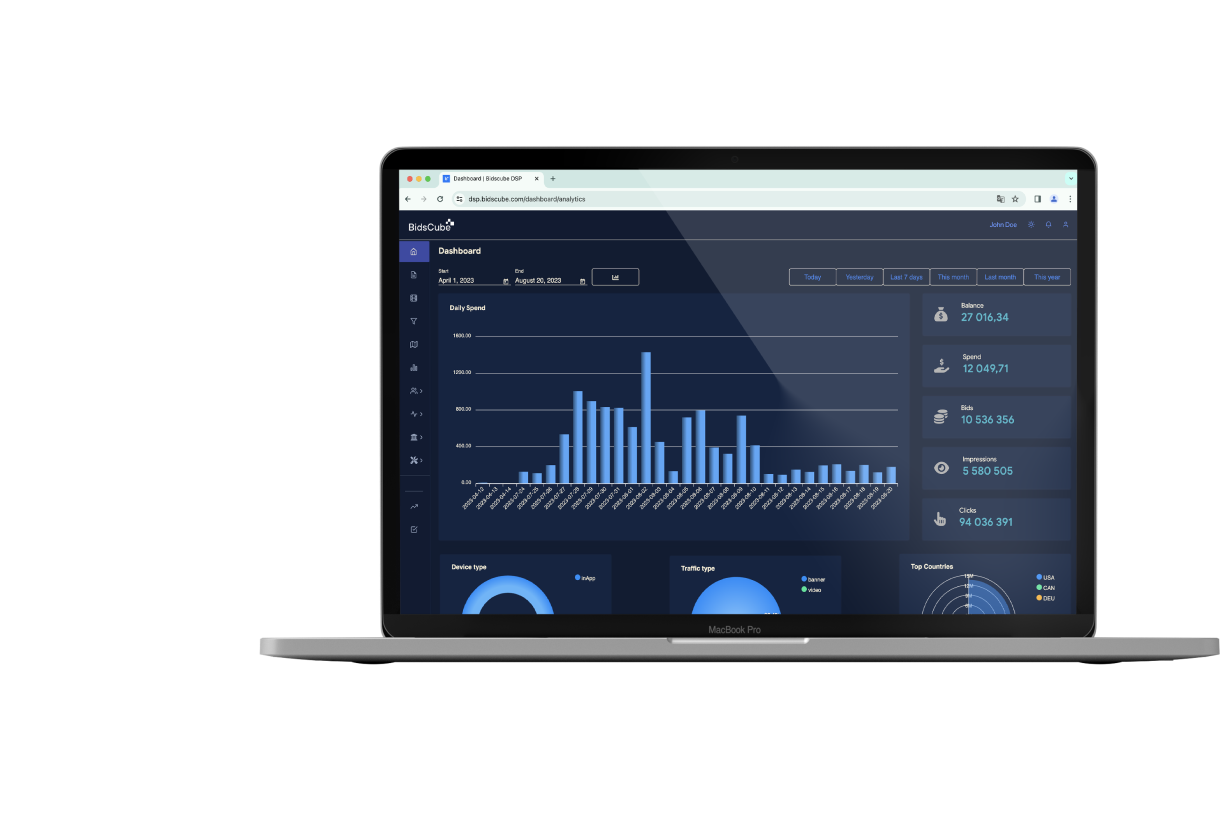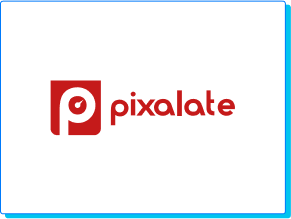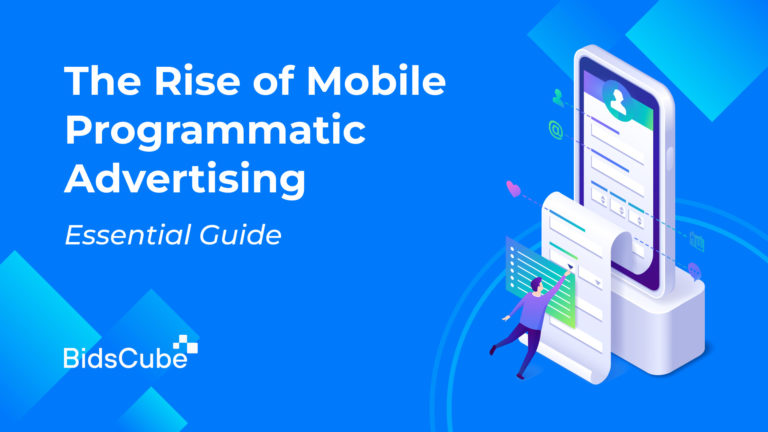It is a simple but professional tool to start advertising at the next efficiency level without any middlemen! Owning a white-label solution gives you control over the data and settings of any part of programmatic trades.




White Label
Demand Side Platform
Grow your brand’s performance with proven white-label programmatic software
BidsCube offers a comprehensive technology solution that lets you tailor a powerful DSP to your specific needs.
Effortlessly integrate diverse supply sources and engage in real-time bidding across various sites and apps.
Gain access to premium publisher inventory swiftly, placing control of your advertising success directly in your hands with our white-label DSP.
-
102M+ imps / mo
Total capacity across all ad formats -
55+
Available campaign settings -
100%
Of verified traffic using leading scanners
All possible formats&devices to deliver ads
-
Banner
-
Video
-
Native
-
Audio
-
Connected TV
-
Desktop
-
Mobile
Explore white-label DSP features
Receive real-time data and control your inventory with the next-step level of efficiency
Get the most out of raw data and unlock the power it provides
Quick troubleshooting on possible no-bid reasons and any other issues
Set up all needed options and targeting to launch an ultimate campaign!
Monitor server load and any other issues that prevent effective advertising.
Manage your campaigns using a convenient platform
Automate routine processes and challenge yourself with something fun instead!
Audience management, Pixels, GPS targeting, AI Optimization, and many more
Get the most out of programmatic advertising with enhanced targeting options!
-
Precise geo-targeting
BE SURE YOUR AD WILL REACH THE RIGHT AUDIENCE IN THE RIGHT LOCATION!
Our white-label demand-side platform is fully equipped with cutting-edge opportunities for geographic targeting. With access to the most precise location data, BidsCube also allows hyperlocal targeting!
- Country, State, City
- IP-address
- Extended GPS targeting
- ZIP codes
- Include/Exclude Option
- Carrier
-
Retargeting
KEEP YOUR PRODUCTS AT THE TOP OF YOUR CUSTOMERS’ MINDS AS THEY CONTINUE BROWSING THE INTERNET
Retargeting is vital in connecting with customers and increasing sales in today’s marketing world. Abandoned carts cost the e-commerce industry $18 billion in lost revenue — if you’re not using retargeting, now is a great time to start!
-
Full control over the campaign budget
DO NOT WORRY ABOUT YOUR FUND’S SAFETY, AND MAKE THE MOST OF EVERY PENNY!
Contact us to launch your own platform and start running impactful ad campaigns. Get full control of the financial side of your advertising campaigns. Be sure that you will get the maximum results at the lowest price!
- Budget Distribution
- Bid Price
- Transaction History
- Convenient Payments
- Daily Cap
- Budget Usage Rate
-
Comprehensive device targeting
Show ads only on the right devices!
Detailed targeting by device and technical connection features allow you to create more accurate advertising campaigns without wasting your budget.
· Browser
· Device language
· Connection Type [Wi-Fi, Celluar]
· Traffic Type [Desktop Web, Mobile Web, Application]
· Device Type [Smartphone/Tablet/PC/Connected TV devices]
· OS
· Carrier -
IAB categories targeting
Reach the audience most interested in your products
BidsCube white-label DSP uses categories classification developed by the Interactive Advertising Bureau (IAB) – the industry standard for digital advertising. More than 360 Tier-1 and Tier-2 categories allow publishers and brands to create the most impactful campaigns which meet the audience’s interests!
The tool is the easiest way to connect with the audience you need. Just choose your business category, and your DSP will find your clients!
-
Dozens of other options for your success
THE SKY’S THE LIMIT! USE THE OTHER BIDSCUBE DSP TARGETING OPTIONS FOR YOUR PROFIT!
- Custom JS / VAST Tags
- Frequency Cap (User IDs or IP addresses)
- Impressions Cap
- Dynamic Price
- Click Optimizer
- Time Targeting
- PMP Deal
- Age&Gender
- And many more!
BE SURE YOUR AD WILL REACH THE RIGHT AUDIENCE IN THE RIGHT LOCATION!
Our white-label demand-side platform is fully equipped with cutting-edge opportunities for geographic targeting. With access to the most precise location data, BidsCube also allows hyperlocal targeting!
- Country, State, City
- IP-address
- Extended GPS targeting
- ZIP codes
- Include/Exclude Option
- Carrier
KEEP YOUR PRODUCTS AT THE TOP OF YOUR CUSTOMERS’ MINDS AS THEY CONTINUE BROWSING THE INTERNET
Retargeting is vital in connecting with customers and increasing sales in today’s marketing world. Abandoned carts cost the e-commerce industry $18 billion in lost revenue — if you’re not using retargeting, now is a great time to start!
DO NOT WORRY ABOUT YOUR FUND’S SAFETY, AND MAKE THE MOST OF EVERY PENNY!
Contact us to launch your own platform and start running impactful ad campaigns. Get full control of the financial side of your advertising campaigns. Be sure that you will get the maximum results at the lowest price!
- Budget Distribution
- Bid Price
- Transaction History
- Convenient Payments
- Daily Cap
- Budget Usage Rate
Show ads only on the right devices!
Detailed targeting by device and technical connection features allow you to create more accurate advertising campaigns without wasting your budget.
· Browser
· Device language
· Connection Type [Wi-Fi, Celluar]
· Traffic Type [Desktop Web, Mobile Web, Application]
· Device Type [Smartphone/Tablet/PC/Connected TV devices]
· OS
· Carrier
Reach the audience most interested in your products
BidsCube white-label DSP uses categories classification developed by the Interactive Advertising Bureau (IAB) – the industry standard for digital advertising. More than 360 Tier-1 and Tier-2 categories allow publishers and brands to create the most impactful campaigns which meet the audience’s interests!
The tool is the easiest way to connect with the audience you need. Just choose your business category, and your DSP will find your clients!
THE SKY’S THE LIMIT! USE THE OTHER BIDSCUBE DSP TARGETING OPTIONS FOR YOUR PROFIT!
- Custom JS / VAST Tags
- Frequency Cap (User IDs or IP addresses)
- Impressions Cap
- Dynamic Price
- Click Optimizer
- Time Targeting
- PMP Deal
- Age&Gender
- And many more!
Industry-leading partnerships & certifications
Advertise with your rules using 100% customizable White-Label DSP

Instead of an expensive and lengthy process of in-house software development, the BidsCube White Label Demand-Side Platform solution will save you money, time and gives you an ultimate package of tools to increase your revenue from day one!
Take full control of your campaign management and advertising process. BidsCube White-Label DSP allows you to establish your terms to maximize your results and create the most profitable cooperation with partners.
Сustomize every part of the platform to your needs and achieve your goals from day one. No one will limit you on the path to success!
By trading exclusively within the secure BidsCube Community environment, you get the opportunity to work with top partners without additional fees and commissions to get even better results!
-
Financial security
100% secure space for all participants -
Direct trading
+250 supply and demand partners -
2ms response time
Trade at unthinkable speed
How does BidsCube Ecosystem work?
All our products are connected and integrated to create the most profitable connection between publishers&advertisers, WLS Partners, and AdTech companies. BidsCube Ecosystem's core goal is to increase the value of every member, depending on his needs!

-
Confidentiality is crucial
By maintaining this clear division, we safeguard the integrity and privacy of your data. Our team operates within this framework, with no access granted to your sensitive information. This steadfast commitment to data protection forms the foundation of our ethos, guiding every decision we make. -
Data Protection as Priority
Ensuring the security of your data is our foremost concern. We uphold a stringent barrier between your personal information and our day-to-day operations, guaranteeing a workspace free from any potential conflicts. This approach underscores our commitment to prioritizing your requirements above all else. -
Your Peace of Mind
Rest assured, your data is handled with the utmost care and discretion. Our unwavering dedication to preserving this separation reflects our unwavering pledge to safeguard your privacy and security. Your trust is of utmost importance to us, and we continuously strive to maintain it through transparency, diligence, and a steadfast focus on your data's confidentiality.
POPULAR QUESTIONS
-
What exactly is a white label DSP platform?
-
How does the BidsCube White Label DSP turbocharge my digital advertising efforts?
-
What ad formats can I manage through the BidsCube White Label DSP?
-
What customization options are available with the BidsCube White Label DSP?
-
What features do you support for working with user segments?







